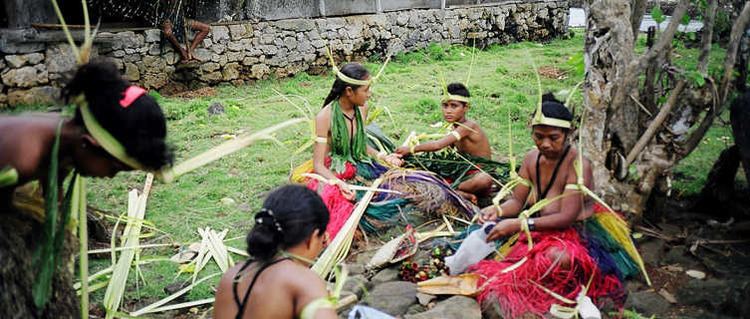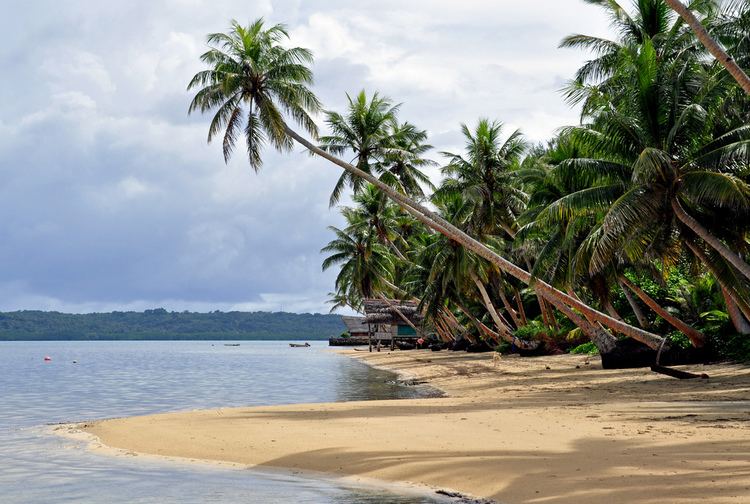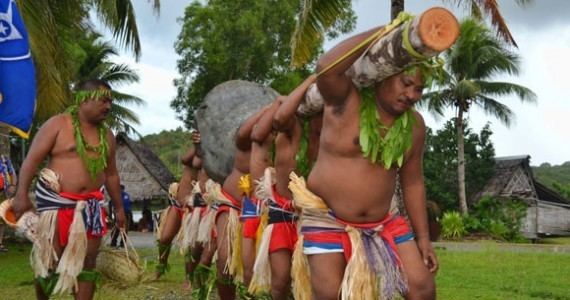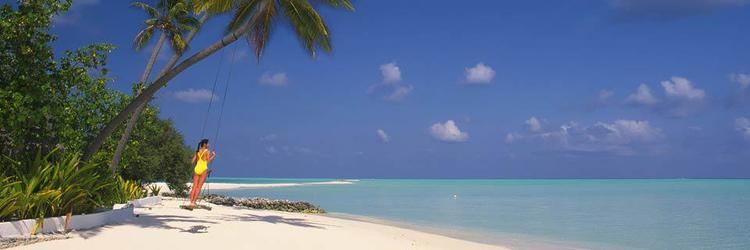Dialing code +691 Area - Total702 km2 271 sq mi Population 103,549 (2013) | ISO code FSM | |
 | ||
Points of interest | ||
Capital Palikir6°55?N 158°11?E? / ?6.917°N 158.183°E? / 6.917; 158.183 Similar Polynesia, Palau, Marshall Islands | ||
Map of Federated States of Micronesia
The Federated States of Micronesia (; abbreviated FSM and also known simply as Micronesia) is an independent sovereign island nation and a United States associated state consisting of four states – from west to east, Yap, Chuuk, Pohnpei and Kosrae – that are spread across the Western Pacific Ocean. Together, the states comprise around 607 islands (a combined land area of approximately 702 km2 or 271 sq mi) that cover a longitudinal distance of almost 2,700 km (1,678 mi) just north of the equator. They lie northeast of New Guinea, south of Guam and the Marianas, west of Nauru and the Marshall Islands, east of Palau and the Philippines, about 2,900 km (1,802 mi) north of eastern Australia and some 4,000 km (2,485 mi) southwest of the main islands of Hawaii.
Contents
- Map of Federated States of Micronesia
- Adapting to climate change in fsm the food water security dimension
- History
- Politics
- Defense and foreign affairs
- Administrative divisions
- Geography
- Economy
- Transportation
- Demographics
- Languages
- Religion
- Health
- Culture
- Literature
- References

While the FSM's total land area is quite small, it occupies more than 2,600,000 km2 (1,000,000 sq mi) of the Pacific Ocean, giving the country the 14th largest exclusive economic zone in the world. The capital is Palikir, located on Pohnpei Island, while the largest city is Weno, located in the Chuuk Atoll.

Each of its four states is centered on one or more main high islands, and all but Kosrae include numerous outlying atolls. The Federated States of Micronesia is spread across part of the Caroline Islands in the wider region of Micronesia, which consists of thousands of small islands divided among several countries. The term Micronesia may refer to the Federated States or to the region as a whole.

The FSM was formerly a part of the Trust Territory of the Pacific Islands (TTPI), a United Nations Trust Territory under U.S. administration, but it formed its own constitutional government on May 10, 1979, becoming a sovereign state after independence was attained on November 3, 1986 under a Compact of Free Association with the United States. Other neighboring island entities, and also former members of the TTPI, formulated their own constitutional governments and became the Republic of the Marshall Islands (RMI) and the Republic of Palau (ROP). The FSM has a seat in the United Nations.

Adapting to climate change in fsm the food & water security dimension
History

The ancestors of the Micronesians settled over four thousand years ago. A decentralized chieftain-based system eventually evolved into a more centralized economic and religious culture centered on Yap.
Nan Madol, consisting of a series of small artificial islands linked by a network of canals, is often called the Venice of the Pacific. It is located on the eastern periphery of the island of Pohnpei and used to be the ceremonial and political seat of the Saudeleur dynasty that united Pohnpei's estimated 25,000 people from about AD 500 until 1500, when the centralized system collapsed.
European explorers—first the Portuguese in search of the Spice Islands (Indonesia) and then the Spanish—reached the Carolines in the sixteenth century. The Spanish incorporated the archipelago to the Spanish East Indies and in the 19th century established a number of outposts and missions. In 1887, they founded the town of Santiago de la Ascension in what today is Kolonia on the island of Pohnpei.
Following defeat in the Spanish–American War, the Spanish sold the archipelago to Germany in 1899 under the German–Spanish Treaty of 1899. Germany incorporated it into German New Guinea.
During World War I, it was captured by Japan. Following the war, the League of Nations awarded a mandate for Japan to administer the islands as part of the South Pacific Mandate.
During World War II, a significant portion of the Japanese fleet was based in Truk Lagoon. In February 1944, Operation Hailstone, one of the most important naval battles of the war, took place at Truk, in which many Japanese support vessels and aircraft were destroyed.
Following World War II, it was administered by the United States under United Nations auspices in 1947 as part of the Trust Territory of the Pacific Islands pursuant to Security Council Resolution 21.
On May 10, 1979, four of the Trust Territory districts ratified a new constitution to become the Federated States of Micronesia. Palau, the Marshall Islands, and the Northern Mariana Islands chose not to participate. The FSM signed a Compact of Free Association with the United States, which entered into force on November 3, 1986, marking Micronesia's emergence from trusteeship to independence. Independence was formally concluded under international law in 1990, when the United Nations officially ended the Trusteeship status pursuant to Security Council Resolution 683. The Compact was renewed in 2004.
Politics
The Federated States of Micronesia is governed by the 1979 constitution, which guarantees fundamental human rights and establishes a separation of governmental powers. The unicameral Congress has fourteen members elected by popular vote. Four senators—one from each state—serve four-year terms; the remaining ten senators represent single-member districts based on population, and serve two-year terms. The President and Vice President are elected by Congress from among the four state-based senators to serve four-year terms in the executive branch. Their congressional seats are then filled by special elections.
The president and vice president are supported by an appointed cabinet. There are no formal political parties.
Defense and foreign affairs
In international politics, the Federated States of Micronesia has often voted with the United States with respect to United Nations General Assembly resolutions.
The FSM is a sovereign, self-governing state in free association with the United States of America, which is wholly responsible for its defense. The Division of Maritime Surveillance operates a paramilitary Maritime Wing and a small Maritime Police Unit. The Compact of Free Association allows FSM citizens to join the U.S. military without having to obtain U.S. permanent residency or citizenship, allows for immigration and employment for Micronesians in the U.S., and establishes economic and technical aid programs.
FSM has foreign relations with 56 countries, including the Holy See. FSM was admitted to the United Nations based on the Security Council's recommendation on August 9, 1991 in Resolution 703 and the General Assembly's approval on September 17, 1991 in Resolution 46/2. The FSM is an active member of the Pacific Islands Forum.
Administrative divisions
The four states in the federation are:
These states are further divided into municipalities.
Geography
The Federated States of Micronesia consists of 607 islands extending 2,900 km (1,802 mi) across the archipelago of the Caroline Islands east of the Philippines. The islands have a combined area of 702 km2 (271 sq mi).
The islands are grouped into four states, which are Yap, Chuuk (called Truk until January 1990), Pohnpei (known as "Ponape" until November 1984), and Kosrae (formerly Kusaie). These four states are each represented by a white star on the national flag. The capital is Palikir, on Pohnpei.
Economy
Economic activity in the Federated States of Micronesia consists primarily of subsistence farming and fishing. The islands have few mineral deposits worth exploiting, except for high-grade phosphate. Long line fishing of tuna is also viable with foreign vessels from China operated in the 1990s. The potential for a tourist industry exists, but the remoteness of the location and a lack of adequate facilities hinder development. Financial assistance from the U.S. is the primary source of revenue, with the U.S. pledged to spend $1.3 billion in the islands in 1986–2001; the CIA World Factbook lists high dependence on U.S. aid as one of the main concerns of the FSM. Geographical isolation and a poorly developed infrastructure are major impediments to long-term growth.
Transportation
The Federated States of Micronesia is served by four international airports.
Demographics
The indigenous population of the nation, which is predominantly Micronesian, consists of various ethnolinguistic groups. It has a nearly 100% Pacific Islander and Asian population: Chuukese 48.8%, Pohnpeian 24.2%, Kosraean 6.2%, Yapese 5.2%, Yap outer islands 4.5%, Asian 1.8%, Polynesian 1.5%, other 6.4%, unknown 1.4%. A sizeable minority also have some Japanese ancestry, which is a result of intermarriages between Japanese settlers and Micronesians during the Japanese colonial period.
There is also a growing expatriate population of Americans, Australians, Europeans, and residents from China and the Philippines since the 1990s. English has become the common language of the government, and for secondary and tertiary education. Outside of the main capital towns of the four FSM states, the local languages are primarily spoken. Population growth remains high at more than 3% annually, offset somewhat by net emigration.
Languages
English is the official and common language. Also spoken are Chuukese, Kosraean, Pohnpeian, Yapese, Ulithian, Woleaian, Nukuoro, and Kapingamarangi.
Other languages spoken in the country include Pingelapese, Ngatikese, Satawalese, Puluwatese, Mortlockese, and Mokilese. There are about 3,000 speakers of Kapingamarangi and Ulithian, and under 1,000 speakers of Nukuoro.
Religion
Most Micronesians are Christian. Several Protestant denominations, as well as the Roman Catholic Church, are present in every Micronesian state. Most Protestant groups trace their roots to American Congregationalist missionaries. On the island of Kosrae, the population is approximately 7,800; 95 percent are Protestants. On Pohnpei, the population of 35,000 is evenly divided between Protestants and Catholics.
On Chuuk and Yap, an estimated 60 percent are Catholic and 40 percent are Protestant. Religious groups with small followings include Baptists, Assemblies of God, Salvation Army, Seventh-day Adventists, Jehovah's Witnesses, The Church of Jesus Christ of Latter-day Saints (Mormons), and the Bahá'í Faith. There is a small group of Buddhists on Pohnpei, and a small group of Ahmadiyya Muslims in Kosrae. Attendance at religious services is generally high; churches are well supported by their congregations and play a significant role in civil society.
Most immigrants are Filipino Catholics who have joined local Catholic churches. The Filipino Iglesia ni Cristo also has a church in Pohnpei. In the 1890s, on the island of Pohnpei, intermissionary conflicts and the conversion of clan leaders resulted in religious divisions along clan lines which persist today. More Protestants live on the western side of the island, while more Catholics live on the eastern side. Missionaries of many religious traditions are present and operate freely. The Constitution provides for freedom of religion, and the Government generally respected this right in practice. The US government received no reports of societal abuses or discrimination based on religious belief or practice in 2007.
Health
Pohnpei is notable for the prevalence of an extreme form of color blindness called Achromatopsia, and known locally as maskun. Approximately 5% of the atoll's 3000 inhabitants are afflicted.
Culture
Each of the four States has its own culture and traditions, but there are also common cultural and economic bonds that are centuries old. Cultural similarities include the importance of the traditional extended family and clan systems and are found on all the islands.
The island of Yap is notable for its "stone money" (Rai stones), large disks usually of calcite, up to 4 meters (13 ft) in diameter, with a hole in the middle. The islanders, aware of the owner of a piece, do not necessarily move them when ownership changes. There are five major types: Mmbul, Gaw, Ray, Yar, and Reng, the last being only 30 cm (12 in) in diameter. Their value is based on both size and history, many of them having been brought from other islands, as far as New Guinea, but most coming in ancient times from Palau. Approximately 6,500 of them are scattered around the island.
Literature
There have been few published literary writers from the Federated States of Micronesia. In 2008, Emelihter Kihleng became the first ever Micronesian to publish a collection of poetry in the English language.
